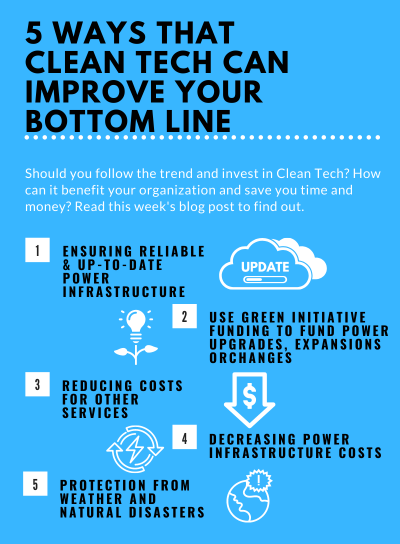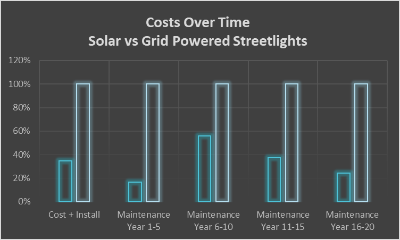BLOG POST: 5 Ways That Clean Tech Can Improve Your Bottom Line

Investors are piling into clean tech with an upswing in investing that considers environmental, social, and governance, or ESG investing, as I recently discussed in my Forbes blog. But when it comes down to the implementation of clean tech in the power sector, we are still overcoming the misperception that cost and reliability is worse than on-grid power solutions. The truth is that power reliability and cost is equitable if not better with renewable off-grid solutions, which can have a positive impact on the bottom line now and in the future. Here are 5 ways that smart off-grid power can positively impact power needs and the bottom line.
![]()
1. Ensuring Reliable & Up-to-date Power Infrastructure
Recently, changing weather patterns have highlighted the inadequacy of North America’s current power infrastructure. More drastic weather swings, like the recent snow storm in Texas and the 2020 wildfires in California are highlighting the shortcomings of the current grid infrastructure in its ability to not only meet current power demands, but withstand weather extremes. This is because many grid systems are older and not designed to meet growing demands or the planet’s weather.
Smart off-grid power can correct these issues without spending billions on a new grid. It can:
- Reduce the amount of grid infrastructure needed by eliminating the burden on distribution and transmission;
- Include software to manage power, which is updated on an ongoing basis, so the system is always up-to-date and gets the predictive analytics algorithms formed from larger analysis of all power systems;
- Provide Energy-as-a-Service, so owners of smart off-grid power systems don’t need to worry about replacing batteries or managing power as this is all automated;
- Ensure that the latest technologies in batteries, control and solar panels/wind turbines are implemented, so the system can optimize its power.
![]()
2. Using Green Initiative Funding to Fund Power Upgrades, Expansions or Changes
With climate change initiatives on the rise and a growing implementation of technology related to the Internet of Things (IoT), governments are funding “smart” or “clean tech” initiatives.
The benefits are numerous: cost savings, environmental impact, reduction in carbon emissions, and safety for citizens. By investigating local and federal funding initiatives, cities and states can implement smart off-grid solutions and save money now as well as in the future.
- Look for a solution to include carbon credit tracking for reporting programs, for programs that want to see the impact;
- Implement technology that can show reporting on power usage to create business cases for savings and gain stakeholder buy in for future upgrades;
- Ensure the investments you make have a very long system life with a guaranteed performance;
- Think outside the box about where you can implement smart off-grid power – industrial lighting for paths, parking lots, city streets, bridges, new housing developments; or nano-grid power packs for telecom towers, IoT solutions, security, grid supplementation, rural power and more. If you do the business case, you will find that there are many applicable projects.
![]()
3. Decreasing Costs for Other Services
Many cities are looking to find cost-effective ways to improve safety, reduce crime rates and improve neighborhoods to reduce money spent on policing, healthcare while attracting business to drive growth in the area.
One way that many cities are looking to do this is through the use of lighting. By lighting rural intersections, main streets or high crime areas, crimes and accidents due to poor visibility can be reduced. Chicago and New York are looking into this with new projects aimed at reducing crime. North Dakota is implementing smart off-grid lighting to illuminate rural intersections.
![]()
4. Reducing Power Infrastructure Costs
When it comes
to installing outdoor lighting, cost plays a huge factor in the decision
regarding which type of solution (on-grid or off-grid) makes the most sense. When
grid power isn’t available or is unreliable, non-expandable, or overtaxed, it
can be a costly endeavor for installation of lighting poles and maintenance.
Cost to implement lighting where grid is required can include:
- Trenching for cabling;
- Grid connection fees, including meters, breakers, distribution panels, commissioning;
- Concrete disruption and repaving costs;
- Hits against the local economy due to longer and bigger construction projects to bring grid power in.
Beyond that, there are monthly utility charges. Depending on whether its public or privatized, as the Texas situation showed us, these costs can vary drastically. When solar-powered streetlights were compared to grid-powered streetlights, the cost differences were staggering in both CAPEX and OPEX.

*Data from Clear Blue’s analysis of total cost of
ownership for Solar powered and grid powered streetlights.
Once upon a
time, the only phone was a land line phone.
Today wireless is the standard.
Soon, wireless power will be the only way we do street lighting. The days of cabling to a pole will be long
past. With the total cost of ownership (TCO) for smart off-grid solutions
significantly lower than on-grid solutions the business case is clear and in favor
of smart off-grid implementation.
![]()
5. Protection from Weather and Natural Disasters
With the growing number of natural disasters decaying infrastructure, the power industry now requires systems that can adapt and anticipate changing weather to protect and provide power to citizens.
Current on-grid systems are often not “smart” and have no resiliency. It’s one big single point of failure. With smart off-grid solutions, customers can avoid lights-out situations, rolling black outs, large wind or extreme heat/cold from knocking out the system.
- Every off-grid system is its own independent system. A street with 10 lights has 10 completely independent power systems. To have the entire street lose its lighting would mean 10 separate systems would have to fail. For the grid, its 1 system – on or off;
- When those off-grid systems are smart, advanced notice of failures are generated for preventative action, remote troubleshooting and maximum uptime is the result;
- Predictive energy and weather forecasting in Smart Off-Grid provides the ability to forecast the service uptime and avoid potential outages, due to winter storms or summer heatwaves;
- Remote energy management and light load control enables energy consumption to be reduced by 5-10% at non critical times. Alternatively, energy can be borrowed from the battery for emergency ride throughs, with the ability to go in later and perform maintenance on the battery remotely to bring the battery back up to full health. In this way, even the worst weather periods can be managed.
Miriam
Tuerk
Co-founder
& CEO
Clear Blue
Technologies

